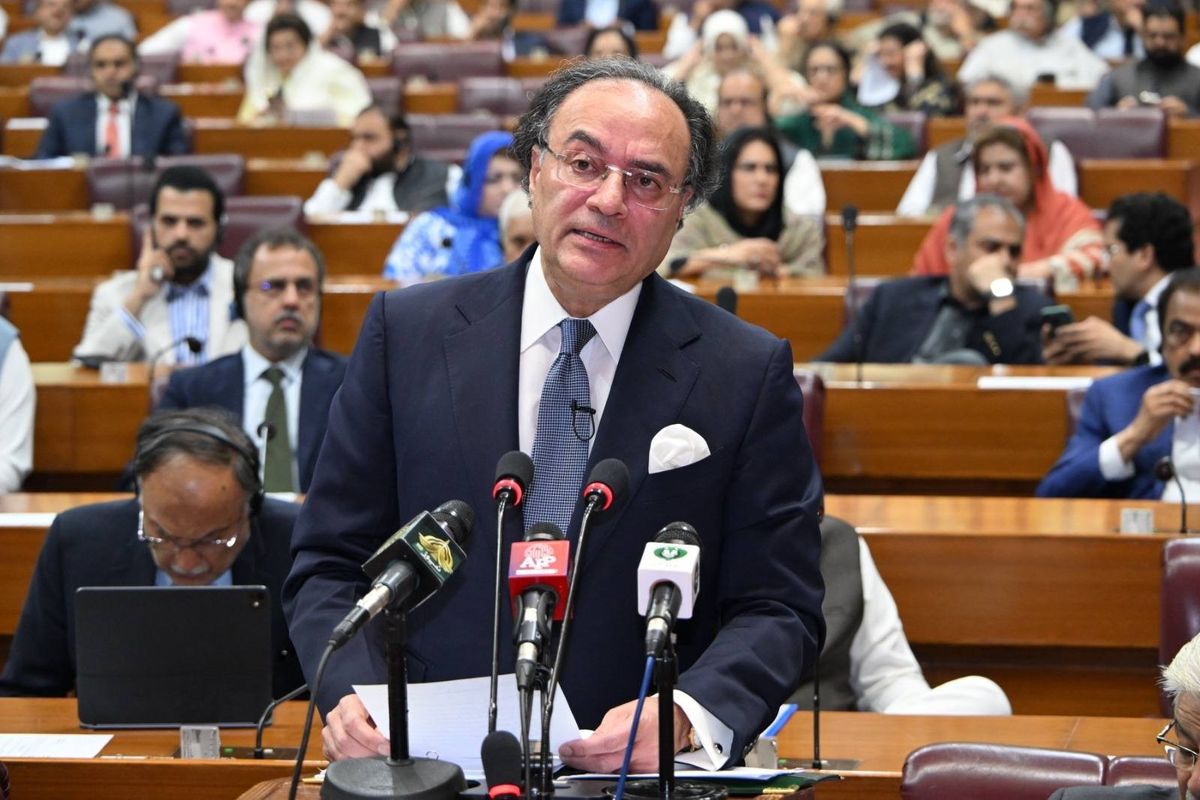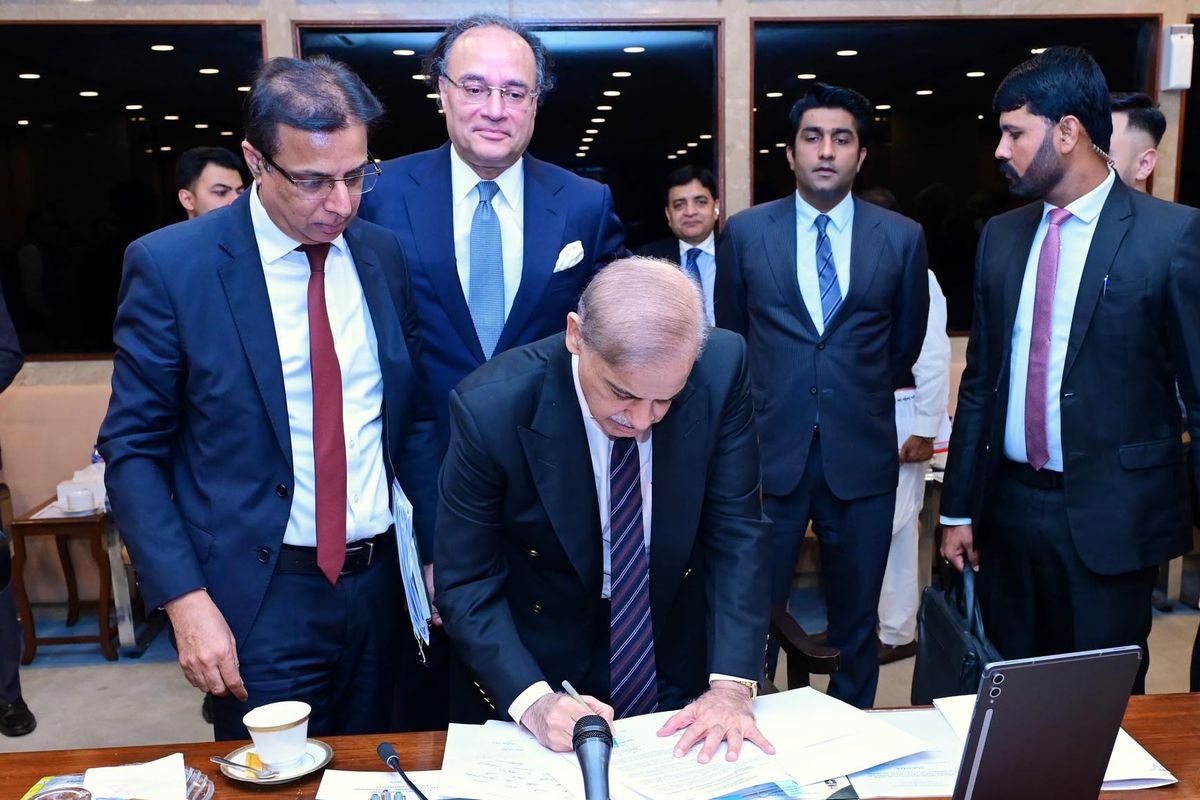News Desk
The News Desk provides timely and factual coverage of national and international events, with an emphasis on accuracy and clarity.

Finance Minister Muhammad Aurangzeb presenting budget for fiscal year 2024-2025 on June 10, 2025.
Courtesy: Facebook/National Assembly of Pakistan
Pakistan on unveiled Tuesday a federal budget of PKR 17,573 billion for the fiscal year 2025–26 as it eyes sustainable economic growth and vows to push ahead with difficult fiscal reforms to achieve that goal.
The budget was presented by Finance Minister Muhammad Aurangzeb in the National Assembly in Islamabad.
It comes a day after the federal government released the Economic Survey of Pakistan, a pre-budget document assessing the past year’s economic performance. The survey reported that the country’s economy grew by 2.7% in the outgoing fiscal year, missing the government’s 3.7% target.
The annual budget outlines the government’s plans to raise revenue, project expenditures, and set targets for inflation and growth. It also details allocations for major sectors such as defense, education, health, and public development.
Key highlights
- Salary adjustments: Grade-1 to Grade-22 salaries will rise by 6%.
- Pension revision: A 7% increase in pensions has been proposed.
- Conveyance allowance: Increased for disabled personnel from PKR 4,000 to PKR 6,000.
- Military benefits: A special allowance for armed forces personnel will be funded through the defense budget.
- Carbon levy: A PKR 2.5/liter levy will be imposed on diesel, petrol, and furnace oil.
- Future levy increase: The carbon levy is set to double next year.
- Solar imports taxation: An 18% tax has been proposed on imported solar panels.
- Online purchases: Platforms like Daraz, Temu, and AliExpress will be subject to an 18% tax, collected by courier companies.
The proposed budget is lower than the revised PKR 18,877 billion outlay for the outgoing fiscal year. Despite this reduction, the government has set ambitious revenue and growth targets to stabilize the economy and restore investor confidence.

The Federal Board of Revenue (FBR) has been tasked with collecting PKR 14,131 billion in FY26, compared to PKR 12,970 billion in FY25.
The government expects a fiscal deficit of PKR 6,540 billion—slightly higher than PKR 6,485 billion in FY25—and plans to spend PKR 8,550 billion on debt servicing, down from PKR 8,930 billion.
Defense, subsidies, and civil expenditures
Defense spending is projected at PKR 2,550 billion in FY26, up from PKR 2,122 billion. Subsidies are budgeted at PKR 1,186 billion, and civil government operational costs are expected to rise to PKR 971 billion from PKR 839 billion.
Grants and transfers to provinces are set to fall to PKR 1,619 billion from PKR 1,777 billion. However, under the National Finance Commission (NFC) award, provinces are expected to receive PKR 8,300 billion in FY26, compared with PKR 7,438 billion this year.
The Public Sector Development Program (PSDP) will receive PKR 1,065 billion—up from PKR 745 billion in FY25.
The target for the petroleum development levy has been raised to PKR 1,311 billion, from PKR 1,117 billion.
Relief for salaried individuals
The government has proposed new income tax slabs for salaried individuals under Division-I, Part-I of the First Schedule:
- Income up to PKR 600,000: No tax.
- PKR 600,001–1.2 million: 1% on income exceeding PKR 600,000.
- PKR 1.2–2.2 million: PKR 6,000 plus 11% of the amount above PKR 1.2 million.
- PKR 2.2–3.2 million: PKR 116,000 plus 23% of income exceeding PKR 2.2 million.
- PKR 3.2–4.1 million: PKR 346,000 plus 30% of income above PKR 3.2 million.
- Above PKR 4.1 million: PKR 616,000 plus 35% on the surplus.
Officials said the changes are designed to reduce the financial burden on salaried workers.
Real estate tax relief to spur growth
To revive the real estate market and promote economic activity, the government has introduced several incentives:
- Withholding tax reduction:
- First slab: Cut from 4% to 2.5%
- Second slab: Reduced from 3.5% to 2%
- Third slab: Lowered from 3% to 1.5%
- Abolition of federal excise duty: The 7% duty on transfers of commercial properties, plots, and houses has been abolished.
- Affordable housing tax credit: Available for purchases of:
- Houses up to 10 marla
- Flats up to 2,000 square feet
- Mortgage financing: The government has pledged to expand mortgage financing, particularly for salaried individuals.
- Stamp duty (Islamabad): Reduced from 4% to 1%.
- YouTube www.youtube.com
Sales tax introduced in KP’s merged districts
For the first time, the newly merged districts of Khyber Pakhtunkhwa will be subject to sales tax at a reduced 10% rate starting next fiscal year.
Aurangzeb said the earlier tax exemption aimed to attract investment and employment, but the new policy seeks to gradually bring these areas into the formal tax system.
Water security amid India tensions
Aurangzeb warned that India has threatened to disrupt Pakistan’s water supply in the wake of bilateral tensions.
“Let me make it clear that water is vital for Pakistan’s survival, and any obstruction in this regard will not be tolerated. India’s hostile intentions will be thwarted completely,” he said.
He added that the situation calls for urgent expansion of water reservoirs. The government, despite limited resources, has committed to accelerating water storage projects under the National Water Policy 2018.
Key goals include:
- Increasing water storage by 10 million acre-feet
- Reducing wastage by 33%
- Improving efficiency by 30%
- Introducing real-time monitoring in the Indus Basin Irrigation System
Of 59 water projects started last year, 34 have been completed at a total cost of PKR 295 billion.
In FY26, PKR 133 billion is allocated for the Water Resources Division. Of this, PKR 102 billion is for 34 ongoing projects, including:
- Diamer-Bhasha Dam: PKR 32.7 billion
- Mohmand Dam: PKR 35.7 billion
- Karachi Bulk Water Supply (K-IV): PKR 3.2 billion
- Lining of Kalri-Baghar Feeder Canal: PKR 10 billion
- Indus Basin Telemetry System: PKR 4.4 billion
- Pit Feeder Canal: PKR 1.8 billion
- Kachhi Canal Flood Repairs: PKR 690 million
- Awaran, Panjgur, Grok, Geshkur Dams: PKR 5 billion
Economic forecasts
- GDP growth: Projected at 4.2% (up from 2.7%)
- Agriculture: 4.5% (vs 0.56% in FY25)
- Industry: 4% (vs 4.77%)
- Services: 4% (vs 2.9%)
- Large-scale manufacturing: Projected rebound of 3.5% (after -1.5% contraction)
- Inflation: Estimated at 7.7% (vs 5.5%)
- Unemployment: Forecast to fall to 7.5% (from 8%)
Trade and remittances
- Exports: Expected to rise to $35 billion (from $31 billion)
- Imports: Projected to grow to $65 billion (from $57.6 billion)
- Remittances: Expected to reach $39 billion (from $38 billion)
Fiscal performance and macroeconomic indicators
Aurangzeb said the budget marks the beginning of a strategic shift toward a more competitive and stable economy. “It will help increase foreign exchange reserves, reduce fiscal payment imbalances, and promote overall economic productivity,” he told the National Assembly.
The government has set a GDP growth target of 4.2% and expects average inflation to remain at 7.5%. The fiscal deficit is projected at 3.9% of GDP, while the primary surplus is expected to reach 2.4% of GDP.
Net federal revenues are estimated at PKR 11,072 billion, and non-tax revenues are targeted at PKR 5,147 billion. The current expenditure of the federal government has been estimated at PKR 16,286 billion, with PKR 8,207 billion earmarked for interest payments.
In terms of fiscal transfers and grants, the government has allocated PKR 1,928 billion for the Benazir Income Support Program (BISP), Pakistan-administered Kashmir, Gilgit-Baltistan, and the newly merged districts of KP. Out of this, BISP funding has been increased by 21% to PKR 716 billion, with coverage expanded to 10 million families.
Aurangzeb added that key macroeconomic indicators have shown positive trends. Primary surplus reached 2.4%, inflation declined to 4.7%, and a current account surplus of $1.5 billion is expected this fiscal year, compared to a $1.7 billion deficit in the previous year.
New tax on foreign digital services
The budget introduces a new legal framework titled the Digital Presence Proceeds Tax Act 2025, aimed at taxing income earned by foreign traders through digital platforms operating within Pakistan's jurisdiction.
Under the proposed law, a 5% tax will be imposed on payments made for goods and services sold by foreign entities to Pakistani consumers. The tax will apply to digital transactions made to overseas traders providing services or products from outside the country.
All financial institutions — including banks, licensed exchange companies, payment gateways, and other regulated entities — will be required to deduct and remit the tax at the time of payment.
The session has been adjourned until 11:00 a.m. on Friday.










Comments
See what people are discussing